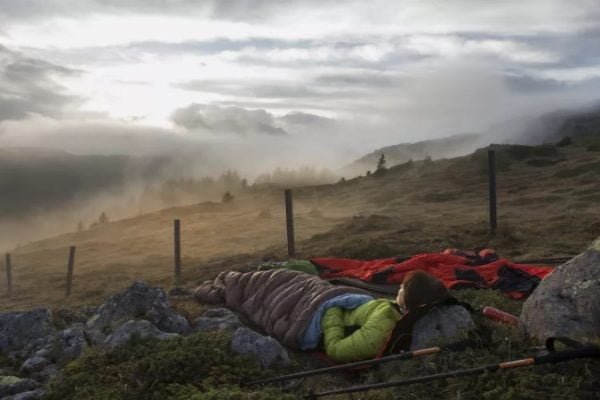The climate of your camping destination and whether you’ll be driving or hiking there should determine the sleeping bag you take. While many people will have a one-size-fits-all sleeping bag that they take on every camping trip, these won’t always be suitable for certain destinations or climates.
Types of Sleeping Bags
The shape of the sleeping bag can significantly affect its ability to keep you warm, its weight (and thus ease of packing), and its comfort.
Rectangular sleeping bags: These are the most simple type of bag and are best suited to camping trips accessed by car because they tend to be quite bulky. Rectangular bags aren’t tapered around the feet and can usually be opened up flat and used like a blanket. Many people will find the extra room around the feet and legs more comfortable, especially star-fish sleepers, but they’re not the best for insulation purposes.
Barrel sleeping bags: These are more tapered than rectangular sleeping bags but roomier than mummy bags. They sometimes have a hood. Barrel sleeping bags are a compromise between comfort and insulation and are best-suited to camping in moderate temperatures or on trips that don’t require too much moving around.
Mummy sleeping bags: These are even narrower at the feet than barrel sleeping bags, have a hood over the head, and are quite snug around the body. They don’t have excess fabric so they tend to be light and pack up small. They can feel quite restrictive, especially if you like to curl up or move around in your sleep, but they’re designed for maximum insulation and are ideal for cold-weather camping.

Elephant’s foot sleeping bags: These are a more specialist type of sleeping bag that mountaineers or more extreme campers use. They are shorter than a “regular” bag and often don’t cover the shoulders because the idea is that you would wear a warm down jacket on the top half of your body. They usually don’t have zippers and are light, so ideal for campers moving from place to place each night and needing minimal gear. They sometimes come with elasticated cords that you attach to your body, to stop the bag from shifting away from you in difficult sleeping conditions, such as at outdoor bivouac shelters.
Women’s sleeping bags: Yes, women can use all of the above-mentioned types of sleeping bags. But these gendered sleeping bags are a separate category because they have a specialized size and shape. The sleeping bags are shorter (with options for 66-inch lengths) with more insulation and tend to be narrower at the shoulders and wider at the hips.
Down Versus Synthetic-Filled Sleeping Bags
The materials a bag is made from will affect its warmth, comfort, weight, water resistance, and price. You’ll typically be choosing from a down fill or a synthetic fill and each has its pros and cons.
Down fill: Down-filled sleeping bags are filled with the feathers and down of water birds such as ducks and geese. These naturally trap warm air and are very light so have a great warmth-to-weight ratio, making them ideal if you’re on a hiking and camping trip. However, they are less water-resistant than good synthetic bags, tend to be more expensive, and are not vegan-friendly.
Synthetic fill: Sleeping bags that aren’t filled with down are usually filled with a synthetic polyester alternative. They’re usually cheaper than down-filled bags and are better suited to wet or humid/damp conditions, but they’re heavier.
Sleeping Bag Liners
While not strictly necessary, sleeping bag liners are a handy extra. Made of silk or cotton, these usually pack up small so don’t take up much room in your pack. In very warm climates you may not need a full sleeping bag and a liner will be all you need overnight, but usually you will place a liner inside the larger sleeping bag. They add another layer of warmth and comfort, and can help keep your sleeping bag clean and prolong its life.
Temperature Ratings
In addition to the shape of your bag and its materials, the temperature or season rating will heavily impact your comfort. While having a heavy winter-weight bag in a hot climate will be annoying, having a summer-weight bag for winter camping could be dangerous. Most sleeping bags include information on their packaging about their upper and lower temperature limits.
Summer-weight bags: These are usually thin and lightweight and only suitable for camping in warm summer climates. If you know the weather is going to be very warm, you might opt for a sleeping bag liner instead.
Three-season bags: These are ideal for most temperate camping trips as they will keep you warm during cold nights in the spring or fall but won’t be too hot on a mild night.
Winter bags: These are generally heavier, bulkier, and more expensive than other bags, but are an important investment if you’ll be camping in cold, sub-zero temperatures.
Tips to Care for and Store Your Sleeping Bag
During your camping trip, try to air your bag in the sun each day. Once you’re home, air your bag outside in the sun on a washing line. This is especially important if it rained on your camping trip. Don’t store it away until it’s completely dry.
Don’t store your bag in the stuff-sack it came in for long periods of time. These are handy for transporting your sleeping bag as you travel, but keeping your bag stuffed in the sack for long periods can damage it
Only wash your bag when absolutely necessary. Spot-clean any dirty patches first, and always follow the care instructions on the bag itself. Hand washing is preferable as washing machines are more likely to damage your bag.
